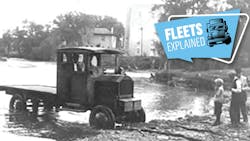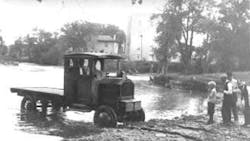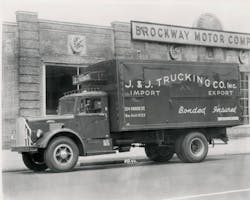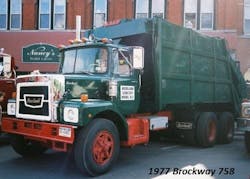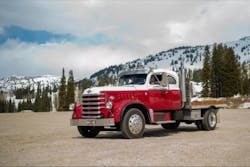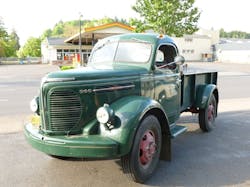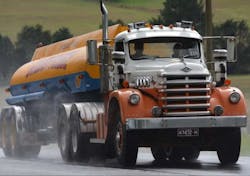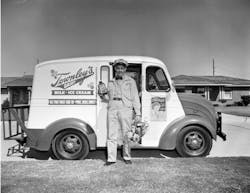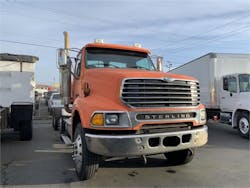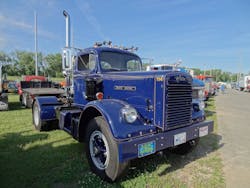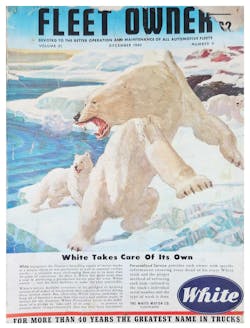Fleets Explained: Iconic truck makers of the 20th century
Key takeaways:
- Many truck OEMs got their start in the early 1900s, but few made it past the Great Depression and WWII. This list compiles those that made it, and their decent into obscurity.
- Some on this list sailed through the hard times, but others barely stayed afloat, saved only by mergers and acquisitions.
- One of the strongest truck OEMs of the 20th century, White Motor Corp., nearly made it to the 21st century, yet piles of debt through acquisitions prevented that from happening.
Just as there are too many electric vehicle startups to count, so too were there many vehicle—and truck—startups that soared into existence and faded into obscurity in the 20th century.
While many consumer vehicle brands began their journey in the early 1900s, the realization that bigger vehicles would be more suited to bigger jobs didn’t fully arrive until the 1910s. Many manufacturers on this list began shortly before, during, or shortly after the first World War. Unfortunately, it was the Great Depression that prevented many young truck manufacturers from making this list or even this list of the seven major truck manufacturers of today.
This list of defunct truck OEMs only includes those that made it through the Great Depression and the post-war era.
American-Coleman Company
The American-Coleman Company started in 1922 in Littleton, Colorado; however, the story of Coleman trucks truly began years earlier in 1916 when Harleigh Holmes, an engineer, patented his designs for four-wheel and front-wheel drive systems, according to Old Cars Weekly. Holmes built trucks with these systems, the Holmes Truck, and founded Holmes Motor Co.
In 1921, Holmes Motor Co. became Plains Motor Corporation and moved 10 miles north to Denver. By that time, the company offered four-wheel drive conversions for Ford vehicles. The following year, two brothers, Alfred and George Coleman, purchased 51% of Plains Motor Corp. and moved the company back to Littleton.
The Holmes Truck’s reputation grew as Holmes and his 30 employees marketed the truck by simply helping other motorists who found themselves stuck along roads, according to the Littleton Museum. A Holmes Truck once rescued a Pierce Arrow truck (a competitor) that was fully loaded with groceries.
The popularity of the truck spawned “pulling” contests, where Holmes wagered $5,000 for any truck that could outperform the Holmes truck. On one occasion, the local paper recorded the Holmes Truck pulling more than a bulldozer.
In 1927, the U.S. Army purchased a truck, by then called a “Coleman Truck,” to haul anti-aircraft guns for testing. In 1928, a Coleman Truck was upfitted with a rotary snowplow, clearing a mountain pass in Colorado.
Coleman Motor Company began developing passenger cars and race cars from the late 1920s through the mid-1930s, even entering two race cars in the 1930 Indianapolis 500. One finished the race in seventh place.
During World War II, the U.S. contracted Coleman Motor Company to build 720 10-ton tractor-trailers to transport light tanks. Additional wartime innovations include a crane-bearing truck built for the U.S. Army Corps of Engineers.
Coleman Motor Company merged with American Road Equipment Company in 1948, changing the company name to American-Coleman Company. U.S. military contracts continued to pour in—one being the aircraft towing tractor, which helped propel American-Coleman to 460 employees.
Harleigh Holmes continued with the company until his death in 1963. His family eventually sold their shares of the company, and by 1968, Kansas City Southern Industries purchased all American-Coleman assets. While the Coleman plant in Littleton continued to build tractors and axles, employment dropped to 21 individuals by 1987. The plant was shuttered, and the story of American-Coleman trucks had ended.
Brockway Motor Truck Co.
In 1909, a New York-based Brockway carriage manufacturer, George A. Brockway, introduced a pilot program seeking to convert his carriage customers into automobile customers, according to Coach Built. With assistance from Aurin M. Chase, founder of Chase Motor Truck, who supplied stripped chassis to Brockway, the Brockway Company built 30 commercial delivery trucks between 1910 and 1912.
In 1912, Brockway and his brother-in-law Frederick Thompson leased a factory to build motor trucks using all third-party components, including Continental engines, Bosch electrics, Bush radiators, and more. Hence, the Brockway Motor Truck Co. was born.
In 1915, Brockway began manufacturing fire trucks, and in 1917 and 1918 supplied “Liberty” trucks to the U.S. military during World War I. When the war ended, Brockway Motor Truck Co. modified the Liberty trucks to create 5-ton trucks for commercial use.
By 1922, the company produced eight different models. In 1928, Brockway Motor Truck Co. merged with Marion, Indiana-based Indiana Truck Corp. After the merger in 1931, Chessie Cummins installed a diesel engine in an Indiana truck, making an Indiana truck the first American truck powered by a diesel engine.
After Brockway’s then-president, Martin O'Mara, was indicted in a stock manipulation scheme, Brockway sold Marion Indiana Truck Corp. to a group of Marion-based businessmen in 1932. The plant operated into the mid-1930s, essentially building Brockway trucks with Indiana badging.
While sales declined, Brockway Motor Trucks made it through the Great Depression and designed even more models along the way—including a line of electric vehicles. By 1935, the Brockway Motors lineup included 36 basic models (not including Brockway’s electric vehicles). It was also in the mid-1930s that Brockway developed the first sleeper cab.
In the 1950s, Brockway supplied vocational vehicles to New York City and Philadelphia sanitation departments. In 1956, Mack Trucks purchased Brockway Motor Company.
The Mack purchase brought two significant changes to Brockway vehicles: Brockway trucks were now powered by Cummins engines instead of Continental engines, and the trucks received a mascot. The decision to include a mascot, a husky, which first appeared as a hood ornament on a 1958 Brockway Model N-260TL, was sparked by Mack Trucks’ bulldog mascot.
While Brockway faced sales declines in the early 1960s, the Model 300 Series, introduced in 1965, proved popular. Additional model developments also helped increase sales into the 1970s.
Unfortunately for Brockway, the Federal Motor Vehicle Safety Standard No. 121, requiring all heavy-duty trucks to include anti-lock air brakes, wreaked havoc on the truck manufacturing industry. Tightening regulations, increasing competition, and labor strikes caused Mack to shutter the Brockway plant, leading to the downfall of Brockway Motor Truck Co.
Diamond T and REO
Diamond T
Founded in Chicago in 1905 by C. A. Tilt, Diamond T produced passenger cars until a customer requested a truck, according to Historic Vehicles. From 1911 until World War I, Diamond T’s truck sales ballooned, and dealerships were established across the nation.
The U.S. military contracted Diamond T to build its “Liberty” military vehicles, and nearly a decade later, the company escaped the effects of the Great Depression, building a truck with increased power output and impressive streamlined designs.
In the years leading up to World War II, Diamond T developed an all-steel frame light truck and established a 100,000-mile warranty. After the war, Diamond T offered a cab-over-engine model, a school bus, and multiple specialized models powered by various engines and transmissions.
After C. A. Tilt’s death, White Motor Corp. purchased Diamond T, and in the following years, Diamond T-branded vehicles began to look more like White trucks. In 1967, White combined Diamond T with another brand, REO, to create Diamond REO.
REO
Ransom E. Olds had his hands in multiple car companies throughout his life, including the truck brand REO. He established REO Motor Car Company in 1905 and introduced the REO Speed Wagon a decade later, according to Historic Vehicles.
The success of the Speed Wagon is apparent, as REO produced more than 125,000 Speed Wagons by 1925. The company also developed a larger version of its truck that year with a two-ton capacity. In 1929, a three-ton capacity truck was introduced.
The Great Depression hit REO hard, and by 1936, the company decided to focus solely on its trucks. While REO received WWII contracts, it did not see much success after the war.
In 1957, REO became a subsidiary of White Motor Company, where the brand was merged with Diamond T in 1967.
Diamond REO
In 1971, White Motor Company sold Diamond REO, which established Diamond REO Trucks Inc. The company sold again in 1974, purchased by Loyal Osterlund and Ray Houseal of Harrisburg, Pennsylvania. The two, who had been Class 8 truck dealers and owned a truck maintenance facility, continued the production of Diamond REO C-116 Giant models. The company finally closed its doors in 1995, according to Diesel World.
See also: Fleets Explained: How the U.S. Interstate System grew the nation and trucking industry
Divco Truck Co.
Though not a heavy truck manufacturer, Divco successfully manufactured delivery vans for six decades.
After his previous employer “balked” at his design—an electric van with driving positions at the front, back, and sides of the van—George Bacon established the Detroit Industrial Vehicle Company in 1922, according to Divco. In 1924, Bacon tested a prototype of his vehicle design, now a gas-powered vehicle, and in 1925, he tested 25 prototypes with the Detroit Creamery.
In 1926, Divco entered the market with a 4-cylinder Continental-powered delivery van. While it was mainly controlled by the front driving position, control from the sides was also possible.
The Divco was expensive, which caused the company to reorganize to the Divco Detroit Corporation. Later, additional models were developed, featuring short hoods, driver positions from the front or side and with seated or standing driving positions, and then a model with a walk-through “aisle” in the back.
Like many at that time, the Great Depression negatively affected Divco. It was sold to Continental Motors in 1932 and renamed Continental-Divco Corporation. In 1936, Divco was divested from Continental and merged with Twin Coach Co. to become Divco-Twin Truck Co.
In 1937, the Divco delivery van was redesigned to feature its famous “snub nose” hood—which would remain throughout the life of the company. Shortly before WWII, Divco also introduced its first refrigerated body, but production of this model was put on hold due to the war.
After WWII in 1944, Twin was dropped from the name, and the company officially became Divco Corporation. It took 10 years after the war in 1954 for Divco Corporation to offer a refrigerated body production unit.
In 1957, Divco purchased Wayne Works, an Indiana-based bus manufacturer, and became Divco-Wayne Corporation. In 1961, Divco-Wayne produced its largest ever vehicle, a refrigerated delivery vehicle available in three lengths: 14 ft., 16 ft., and 18 ft.
Throughout the following years, Divco was bought and sold numerous times until its final acquisition by Delaware-based Correct Manufacturing.
Correct Manufacturing declared bankruptcy in 1985, and Divco assets were sold, marking the end of Divco and its snub-nosed delivery trucks.
Sterling Motor Truck Co.
In the early 1900s, William Sternberg established a vehicle manufacturing company under his own name. By 1916, he changed the name of his company to Sterling. Sterling built its trucks from the ground up using Sterling engines, Sterling transmissions, and other Sterling-exclusive components, according to Coach Built.
Throughout the 1920s and 1930s, Sterling perfected and added to its lineup of trucks. In 1932, the company expanded through the acquisition of La France-Republic, another vehicle manufacturer out of Alma, Michigan. Throughout the late 1930s, Sterling developed its cab-over models, equipped with Cummins engines.
The company received war contracts during WWII as well as additional specialized government contracts after the war.
Post-war sales peaked and then hit a decline. White Motor Corporation purchased Sterling in 1951. Two years later, White purchased Autocar, another truck manufacturer. The Sterling trucks and Autocar trucks were quite similar, eventually leading White to discontinue the Sterling brand.
Nearly 50 years later, the Sterling name was revived when Daimler-Benz purchased Ford’s heavy-duty truck division, according to Hammer Trucks. The new Sterling Trucks operated as a subsidiary of Daimler Truck North America.
During an economic downturn in 2008, Daimler Truck decided to close the Sterling plants and discontinue the brand to focus on a “two-brand” strategy with Freightliner and Western Star, FleetOwner reported.
Sterling dealers ceased to accept orders for new Sterling trucks the following January, marking the end of Sterling Trucks.
White Motor Corporation
The White Motor Car Company was established in 1906 by the White brothers, Rollin, Windsor, and Walter. It eventually began as a segment of their father’s business, White Sewing Machine Company. White Motor Car Co. produced its first vehicle in 1909 and shifted to trucks during WWI, according to the Encyclopedia of Cleveland History.
The company continued to focus on truck manufacturing even after the war, becoming a top maker of trucks and specialty vehicles. White briefly merged with auto brand Studebaker in 1932 due to the hard times of the Great Depression, yet it was able to buy out its independence two years later. Throughout the ‘20s and ‘30s, it remained a top manufacturer of trucks and buses until the Second World War.
Once WWII was underway, the White truck factory in Cleveland was converted to a military truck plant.
After the war, White strategically purchased smaller truck and farm equipment manufacturers. As a result, “the company increased sales from $130 million in 1950 to $770 million in 1967,” the Encyclopedia of Cleveland History states.
Unfortunately, these acquisitions put White Motor Corporation heavily in debt. Semon "Bunkie" Knudsen was hired to reorganize the company in 1970, but years of recession, industry changes, inflation, and White’s prior years of mismanagement could not be undone.
The company eventually moved its manufacturing headquarters to Virginia and shifted from truck production to parts fabrication. White filed for bankruptcy in 1980. In 1981, Sweden's AB Volvo purchased White’s truck factories, and White officially ceased as a company in 1985. Volvo eventually retired the White name in the 1990s.
About the Author
Jade Brasher
Senior Editor Jade Brasher has covered vocational trucking and fleets since 2018. A graduate of The University of Alabama with a degree in journalism, Jade enjoys telling stories about the people behind the wheel and the intricate processes of the ever-evolving trucking industry.
